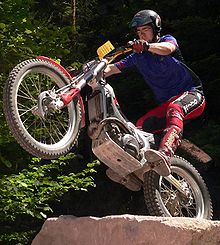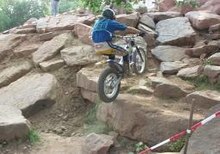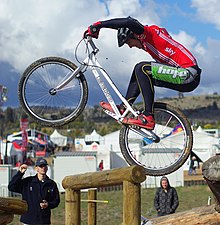Trial (sport)
Trial competitions or trials ( Engl. Trial "testing") are tests of skill in heavy terrain may be come to a standstill even where neither the distance limitations or markings touched. The time driven does not matter for the placement. Trials have been contested in England since the automobile was developed.
Auto trial
Until the 1980s, trial cars were mainly in-house designs made from a thinly clad tubular space frame with an old used car engine .
A crank handle on the steering wheel and a separate handbrake on each of the right and left rear wheels optimize handling .
The trials were particularly popular in the late 1940s and 1950s in the British Isles, as one could present thrilling motorsport with limited financial and material means, but enthusiastic "tinkering" . Many racing drivers in the higher classes earned their first merits here , as in the hill climbs , such as Ken Wharton , who made it into Formula 1 .
Truck trial
The truck trials (also called truck trials ) have been around since the 1980s . The trucks drive with special all-wheel drive and short chassis on extreme courses . At the European Championship and the German Championship, five near-series (S1-S5) and two prototype classes (P1-P2) are driven.
Motorcycle trial
The term trial comes from England, where motorcyclists had been trying to cross rough terrain with the motorcycles produced at the time since the beginning of the 1910s. Soon there were machines that were better adapted to the terrain difficulties, the driving techniques were refined in the course of development, and trial riders became masters of balance and style, with which this motor sport developed into the high school of motor sport on two wheels.
In the motorcycle trial, the focus is on mastering the machine in the special tests called "sections". The travel time plays a subordinate role, although the maximum travel time is set in order to keep an event under control. These sections are selected by experienced specialists; A course that is at least 1.2 m wide through ditches, mud, over roots, stones and high steps, tight bends around trees or other obstacles must be driven through with as few errors as possible. The beginning and end of the section are marked with A and E signs; points are only scored between these. Error-free means overcoming all difficulties while driving, i.e. not stopping, pushing or even falling, but also without helping with your feet. These are all errors that are noted for the driver on a points card with different ratings.
The trial rider usually drives slowly, maneuvers the front and rear wheels with centimeter accuracy, skilfully lifts the front wheel up a step with a throttle and jumps over obstacles, always trying to complete the section without errors. Judges watch every movement of the driver and machine, not the fastest "dab", the light touch of a foot on the ground, must escape them. The correct level of difficulty of a section is considered to have been reached if it is mastered by two or three drivers without any mistakes.
Special trial motorcycles are used . The machines have high ground clearance, low weight, a large steering angle and motors that respond to the slightest turn of the throttle grip. The tires are also an important factor; only the right tire in conjunction with an air pressure adapted to the section ensures the necessary propulsion.
Motorcycle trial essentially consists of two sections, the classic car trial and “modern” motorcycle trial. There are competitions for both types.
Competitions consist of four rounds with mostly 7 or 8 sections. But there are also competitions with three rounds of 10 sections. The sections are usually marked with a barrier tape (red / white), an A (start) and an E (end) sign. Different classes, which are divided into colors, ensure justice in terms of difficulty. Each participant receives a points card for each round on which his "penalty points" are entered:
- Dropping the foot : 1 penalty point (a maximum of 3 possible; then petting the section justified)
- Fall , roll backwards or switch off the engine : 5 penalty points (require leaving the section)
Indoor trials also originated in England. This indoor variant only developed a few years ago when the aim was to make the sport known to a wider public.
Each team has three motorcycle riders, each of whom has to drive a third of the sections. With six sections, each driver has to drive twice. The ratings are as follows: Without a foot on earth: 0 points; One foot: 1 point; Two feet: 2 points; Three times feet: 3 points; more than three feet: 3 points; Fall: 5 points; Leaving the section: 5 points. With 5 points the driver is excluded. The motorcycle rider with the fewest points wins.
Bike trial
Bicycle trial (also called bike trial) developed in the early 1970s. On May 25, 1974, the very first competition took place in Bad Nauheim. There are two world associations, the UCI and the BikeTrial International Union. The UCI is home to all cycling sports. The BIU is a world association that only runs bicycle trials. The BIU currently has 39 countries. In Germany, bike trials for licensed riders run under the supervision of the BDR (Bund Deutscher Radfahrer).
Basically Trials are ridden with bikes without suspension and without a saddle. Two types of bicycles are trialled - smaller 20-inch (wheel diameter) trial bikes and 26-inch trial mountain bikes derived from the usual mountain bike. The main differences to other mountain bikes are the very low frame height ; the missing or only hinted at seating, which leads to more freedom of movement; no suspension fork and few gears, as only small gear ratios are required; and the very low weight of the frame for easier hopping on the trial bike. There is usually no gear shift at all on the 20-inch wheels.
Trials are held wherever it is possible - even if it is not allowed there. Both nature and cities (urban or street trial) offer attractive obstacles. Of course there is also the indoor version, particularly suitable for competitions.
In the trial, it is important to have perfect control of the bike in every situation. Trialers don't just drive, they jump and jump over all imaginable obstacles, often at dizzying heights. Body control, a sense of balance, concentration, strength, endurance and courage are both challenged and encouraged. But imagination is also important, because the most suitable driving technique must be selected for every situation.
In trials, the goal is to move a bike with a special geometry through a natural or artificial course with as little physical contact as possible (with the ground or obstacle) . Elite sections are often so difficult that they are difficult or impossible to tackle even on foot. A section is a section of terrain that is provided with ribbons, boards and arrows that indicate the lanes of the various categories. Each category is identified by its own color. A section can contain a wide variety of elements, such as steep ascents or descents, creek crossings, root passages, rocks, tree trunks or stumps, with gravel, sloping slopes or mud passages. These natural sections are often supplemented by artificial ones. Common elements here are concrete pipes, pallets, cable reels, boards, oil drums or disused cars. A section must be completed in a given time (e.g. 2 minutes). Depending on the age category and the organizer, four to eight sections have to be passed through, usually three or four times.
Pioneer in the commercialization of trial sport
- Hans Rey, Libor Karas
Trials and trials shows were so spectacular as early as the mid-1990s that large manufacturers integrated drivers into their teams as professionals.
- Danny Macaskill
Danny Macaskill rode for the Inspired Bicycles Team Trial even before his breakthrough. However, he did not take part in competitions, but limited himself exclusively to street trials. The Scot shot a street trial video with a fellow student in April 2009 and posted it on YouTube. This step made him the most famous trialer in the world. His video has now been viewed nearly 40 million times.
- Kenny Belaey
Kenny Belaey is a Belgian professional trialer. In contrast to Danny Macaskill, Kenny Belaey takes part in many high-profile trials competitions and he has already won the world championship several times. Belaey's videos could be brought to the public through a separate broadcast on 'Extreme Sportschannel'.
- Fabio Wibmer
Fabio Wibmer is an Austrian trial professional. Fabio Wibmer drove motocross races for twelve years in his youth. In 2009, he became aware of the bike trial sport through a YouTube video by Scottish trial superstar Danny MacAskill. The actual first contact with this sport finally took place in winter 2010 with his first own trial bike. In 2012, at the age of 16, he was invited to the Red Bull Wings Academy in Munich. Since 2014 he has been touring the world with other bike trial riders as a permanent member of the “Drop & Roll Street Trial Show” founded by MacAskill, partly internationally.
Driving techniques
- The backwheel hop
Hopping on the rear wheel is a technique that you cannot do without in the higher classes in trials. She is z. B. used when there is not enough space to stand on an obstacle with both wheels at the same time, or when large jumps from obstacle to obstacle are required (“pedal kicks”). Backwheel hops are often the first choice even for big jumps down . The easiest way to learn is to hop backwards on the rear wheel. Jumping on the spot requires a lot of coordination, and jumping forward with the pedal kicks is actually one of the most difficult of all driving techniques in trials.
- The pedal kick
Pedal kicks are jumps forward from the rear wheel. With them you can z. B. Skip gaps of 2 m and more. Even quite high steps can be overcome with a front pedal kick . To do this, you let yourself fall forwards while hopping or standing on the rear wheel and then jump after your balance by explosively moving your hips towards the handlebars , releasing the rear brake and giving a powerful kick to the pedals . You can have several pedal kicks follow one another or prepare for the next jump first with smaller hops on the rear wheel.
- The "Coustellier"
[Short form "Coust"; Verb: "cousten"]
This technique is named after the French brothers Gilles and Giacomo Coustellier, who developed and first used the trial technique. Technically, it is based on the “pedal kick” principle; The landing is carried out by shifting the body's center of gravity forward on the front wheel of the obstacle being controlled. With a renewed shift of body weight and a simultaneous and sensitive “opening” of the front brake, the driver then “cousts” back to the rear wheel or coasts down on both wheels. Although the "coustellier" requires a higher degree of coordination and precision, it offers the experienced driver elementary advantages. On the one hand, the driver needs less space to stand on the targeted obstacle, as he does not have to land on it with both wheels at the same time. On the other hand, it is possible to bridge a greater distance compared to the “pedal kick”.
Unicycle trial
Similar to the motorcycle trial, unicyclists also developed a variant of the trial sport. Stable 20-inch trial unicycles with a soft, wide tire serve as a trial device. You drive over pallets, thin pipes or railings, tree trunks, etc. Basically, the obstacles are very similar to a bicycle trial. Kris Holm is the best known and one of the best unicycle trial athletes in the world. He also influenced this sport the most.
Unicycling trial athletes use the so-called “free trials” rules, which were written by Kris Holm, as a set of rules. Usually one point is awarded for every completed trial line. Whoever achieves the most points on a trial course with many lines within a certain period of time wins. A "line" can be repeated as often as required.
Model truck trial
Since the mid-nineties there has also been a trial division in model making. In 1997 , at the Faszination Modellbau trade fair in Sinsheim , model makers took part in the competition for the first time. At that time also with two-wheel drive models, but they soon disappeared. Over the years, the model truck trial has based its set of rules on the large originals without losing sight of the special features of the models. Competitions in this area take place all year round in almost all of Germany. Friends of this model sport can also be found in neighboring countries.
You can drive anywhere. On a construction site, a sand hill or on a trip into the forest. With the help of wooden sticks, gates are inserted, which then have to be driven through without contact.
various
Today there are "trials" of all kinds: While motocross machines and mountain bikes race against each other in a similar mode, but also against the clock, today a great many types of races are almost indiscriminately named.
Individual evidence
- ↑ Trial Magazine: Interview with Danny Macaskill. (No longer available online.) Archived from the original on July 25, 2015 ; Retrieved June 18, 2015 .
- ↑ Trial Magazine: Kenny Belaey on commerce in trials. (No longer available online.) Archived from the original on January 20, 2015 ; Retrieved June 18, 2015 .
literature
- Truck trial
- Markus Bauer, Thomas Paul Göttl (Eds.): Truck sport book 2011 - Truck Race & Truck Trial European Championship. ETM Services, Stuttgart and Motorbuch-Verlag, Stuttgart 2011. ISBN 978-3-613-30682-0 .
- Motorcycle trial
- Bernard Jonzier, Renate Daric (translator): The green sport - all about trial and motocross. Motorbuch-Verlag, 2nd edition, Stuttgart 1979. ISBN 3-87943-505-7 .
- Felix Krahnstöver, Harry Niemann: Trial - Acrobatics on 2 Wheels (a textbook). Motorbuch-Verlag, 1st edition, Stuttgart 1988. ISBN 3-613-01221-9 .
- Volker Rauch: What is Trial? Interesting facts about trial sport and the German Trial Championship. Zündapp-Werke, Munich 1961 (32 pages) and 1962 (35 pages)
- Trialsport - The magazine for trial drivers. Magazine, Greiner, Freudenberg, from 1985. online: trialsport.de
- Bike trial
- Hansjörg Rey, Thomas Rögner: No way - bike trial tricks. (Balancing, easy over obstacles, hot descents, show tricks). Delius Klasing, Bielefeld 1993. ISBN 3-7688-0792-4 .
Web links
- TRIAL MAGAZINE - The magazine for the latest news on trial from the areas of news, people, lifestyle, results, technology and media. We love trials!
- TRIALSPORT: The magazine for trial riders - the classic motorcycle trial for over 30 years
- FACTION APP: The leading app to enter and find spots for bike trials and other sports







